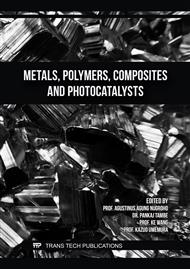[1]
Ngo TD, Kashani A, Imbalzano G, Nguyen KTQ, Hui D. Additive manufacturing (3D printing): A review of materials, methods, applications and challenges. Compos B Eng 2018;143:172–96.
DOI: 10.1016/j.compositesb.2018.02.012
Google Scholar
[2]
Ni H, Zeng Q, Zhang K, Chen Y, Wang J. Mechanical Properties and Fracture Behavior of Laser Powder-Bed-Fused GH3536 Superalloy. Metals (Basel) 2022;12.
DOI: 10.3390/met12071165
Google Scholar
[3]
Hosseinzadeh A, Radi A, Richter J, Wegener T, Sajadifar SV, Niendorf T, et al. Severe plastic deformation as a processing tool for strengthening of additive manufactured alloys. J Manuf Process 2021;68:788–95.
DOI: 10.1016/j.jmapro.2021.05.070
Google Scholar
[4]
Mishra A, Agarwal R, Kumar N, Rana A, Kumar Pandey A, Dwivedi SP. A critical review on the additive manufacturing of aluminium alloys. Mater Today Proc, vol. 47, Elsevier Ltd; 2021, p.4074–8.
DOI: 10.1016/j.matpr.2021.05.698
Google Scholar
[5]
Chowdhury S, Yadaiah N, Prakash C, Ramakrishna S, Dixit S, Gupta LR, et al. Laser powder bed fusion: a state-of-the-art review of the technology, materials, properties & defects, and numerical modelling. Journal of Materials Research and Technology 2022;20:2109–72.
DOI: 10.1016/j.jmrt.2022.07.121
Google Scholar
[6]
Van Cauwenbergh P, Samaee V, Thijs L, Nejezchlebová J, Sedlák P, Iveković A, et al. Unravelling the multi-scale structure–property relationship of laser powder bed fusion processed and heat-treated AlSi10Mg. Sci Rep 2021;11.
DOI: 10.1038/s41598-021-85047-2
Google Scholar
[7]
Shakil SI, Hadadzadeh A, Pirgazi H, Mohammadi M, Haghshenas M. Indentation-derived creep response of cast and laser powder bed fused AlSi10Mg alloy: Air temperature. Micron 2021;150.
DOI: 10.1016/j.micron.2021.103145
Google Scholar
[8]
Radi A, Duygulu O, Isil C, Yapici GG. On the strain rate sensitivity of a TRIP assisted high entropy alloy. Mater Lett 2023;333.
DOI: 10.1016/j.matlet.2022.133610
Google Scholar
[9]
Rosenthal I, Stern A, Frage N. Strain rate sensitivity and fracture mechanism of AlSi10Mg parts produced by Selective Laser Melting. Materials Science and Engineering A 2017;682:509–17.
DOI: 10.1016/j.msea.2016.11.070
Google Scholar
[10]
Olakanmi EO, Cochrane RF, Dalgarno KW. A review on selective laser sintering/melting (SLS/SLM) of aluminium alloy powders: Processing, microstructure, and properties. Prog Mater Sci 2015;74:401–77.
DOI: 10.1016/j.pmatsci.2015.03.002
Google Scholar
[11]
Picu RC, Vincze G, Ozturk F, Gracio JJ, Barlat F, Maniatty AM. Strain rate sensitivity of the commercial aluminum alloy AA5182-O. Materials Science and Engineering A 2005;390:334–43.
DOI: 10.1016/j.msea.2004.08.029
Google Scholar
[12]
Yan SL, Yang H, Li HW, Yao X. Variation of strain rate sensitivity of an aluminum alloy in a wide strain rate range: Mechanism analysis and modeling. J Alloys Compd 2016;688:776–86.
DOI: 10.1016/j.jallcom.2016.07.077
Google Scholar
[13]
Karaman I, Yapici GG, Chumlyakov YI, Kireeva I V. Deformation twinning in difficult-to-work alloys during severe plastic deformation. Materials Science and Engineering A 2005;410–411:243–7.
DOI: 10.1016/j.msea.2005.08.021
Google Scholar
[14]
Harun HJ, Mccormick PG. Effect of precipitation hardening on strain rate sensitivity and yield behaviour in an Al-Mg-Si alloy
DOI: 10.1016/0001-6160(79)90067-1
Google Scholar
[15]
Hähner P., On the critical conditions of the Portevin-Le Châtelier effect. vol. 45. Acta Metallurgica Inc; 1997
DOI: 10.1016/S1359-6454(97)00066-9
Google Scholar
[16]
Mulford RA, Kocks New observations on the mechanisms of dynamic strain aging and of jerky July 1979, Pages 1125-1134
DOI: 10.1016/0001-6160(79)90130-5
Google Scholar
[17]
Kabirian F, Khan AS, Pandey A. Negative to positive strain rate sensitivity in 5xxx series aluminum alloys: Experiment and constitutive modeling. Int J Plast 2014;55:232–46.
DOI: 10.1016/j.ijplas.2013.11.001
Google Scholar
[18]
Sajadifar SV Hosseinzadeh A, Krochmal M, Wegener T, Bolender A, et al. On the Friction Stir Processing of Additive-Manufactured 316L Stainless Steel. Advanced Engineering Materials 2022;24:2200384. https://doi.org/.
DOI: 10.1002/adem.202200384
Google Scholar


